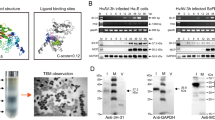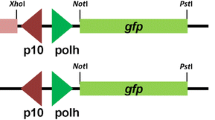Abstract
The genome of Chilo iridescent virus (CIV) has two open reading frames (ORFs) with matrix metalloprotease (MMP) domains. The protein encoded by ORF 136R contains 178 amino acids with over 40% amino acid sequence identity to hypothetical metalloproteases of other viruses, and the protein 165R contains 264 amino acids with over 40% amino acid sequence identity to metalloproteases of a large group of organisms, primarily including a variety of Drosophila species. These proteins possess conserved zinc-binding motifs in their catalytic domains. In this study, we focused on the functional analysis of these ORFs. They were cloned into the Autographa californica multiple nucleopolyhedrovirus (AcMNPV) Bac-to-Bac baculovirus expression-vector system, expressed in insect Sf9 cells with an N-terminal His tag, and purified to homogeneity at 72 hours postinfection using Ni-NTA affinity chromatography. Western blot analyses of purified 136R and 165R proteins with histidine tags resulted in 24- and 34-kDa protein bands, respectively. Biochemical assays with the purified proteins, performed using azocoll and azocasein as substrates, showed that both proteins have protease activity. The enzymatic activities were inhibited by the metalloprotease inhibitor EDTA. Effects of these proteins were also investigated on Galleria mellonella larvae. Insecticidal activity was tested by injecting the larvae with the virus derived from the AcMNPV bacmid carrying 136R or 165R ORFs. The results showed that the baculoviruses harbouring the iridoviral metalloproteases caused early death of the larvae compared to control group. These data suggest that the CIV 136R and 165R ORFs encode functional metalloproteases. This study expands our knowledge about iridoviruses, describes the characterization of CIV matrix metalloproteinases, and might ultimately contribute to the use of this virus as a research tool.




Similar content being viewed by others
References
Ahlers LR, Bastos RG, Hiroyasu A, Goodman AG (2016) Invertebrate ıridescent virus 6, a DNA virus, stimulates a mammalian ınnate ımmune response through RIG-I-like receptors. PLoS One 11:e0166088
Bode W, Gomis-Rüth F-X, Stöckler W (1993) Astacins, serralysins, snake venom and matrix metalloproteinases exhibit identical zinc-binding environments (HEXXHXXGXXH and Met-turn) and topologies and should be grouped into a common I, the ‘metzincins’. FEBS Lett 331:134–140
Bronkhorst AW, van Cleef KW, Vodovar N, Ince IA, Blanc H, Vlak JM, Saleh MC, van Rij RP (2012) The DNA virus ınvertebrate iridescent virus 6 is a target of the Drosophila RNAi machinery. Proc Natl Acad Sci USA 109:E3604–E3613
Charney J, Tomarelli RM (1947) A colorimetric method for the determination of the proteolytic activity of duodenal juice. J Biol Chem 171:501–505
Chavira R Jr, Burnett TJ, Hageman JH (1984) Assaying proteinases with azocoll. Anal Biochem 136:446–450
Chinchar VG, Hick P, Ince IA, Jancovich JK, Marschang R, Qin Q, Subramaniam K, Waltzek TB, Whittington R, Williams T, Zhang QY, Ictv Report C (2017) ICTV virus taxonomy profile: ıridoviridae. J Gen Virol 98:890–891
Chitnis NS, Paul ER, Lawrence PK, Henderson CW, Ganapathy S, Taylor PV, Virdi KS, D’Costa SM, May AR, Bilimoria SL (2011) A virion-associated protein kinase induces apoptosis. J Virol 85:13144–13152
Constantino M, Christian P, Marina CF, Williams T (2001) A comparison of techniques for detecting Invertebrate iridescent virus 6. J Virol Methods 98:109–118
Eaton HE, Metcalf J, Penny E, Tcherepanov V, Upton C, Brunetti CR (2007) Comparative genomic analysis of the family Iridoviridae: re-annotating and defining the core set of iridovirus genes. Virol J 4:11
Elkington PT, O’Kane CM, Friedland JS (2005) The paradox of matrix metalloproteinases in infectious disease. Clin Exp İmmunol 142:12–20
Frantz C, Stewart KM, Weaver VM (2010) The extracellular matrix at a glance. J Cell Sci 123:4195–4200
Gomis-Ruth FX (2003) Structural aspects of the metzincin clan of metalloendopeptidases. Mol Biotechnol 24:157–202
Gramkow AW, Perecmanis S, Sousa RLB, Noronha EF, Felix CR, Nagata T, Ribeiro BM (2010) Insecticidal activity of two proteases against Spodoptera frugiperda larvae infected with recombinant baculoviruses. Virol J 7:143
Harrison RL, Bonning BC (2010) Proteases as insecticidal agents. Toxins 2:935–953
Hawtin RE, Zarkowska T, Arnold K, Thomas CJ, Gooday GW, King LA, Kuzio JA, Possee RD (1997) Liquefaction of Autographa californica nucleopolyhedrovirus-infected insects is dependent on the integrity of virus-encoded chitinase and cathepsin genes. Virology 238:243–253
Ishimwe E, Hodgson JJ, Clem RJ, Passarelli AL (2015) Reaching the melting point: degradative enzymes and protease inhibitors involved in baculovirus infection and dissemination. Virology 479–480:637–649
Ishimwe E, Hodgson JJ, Passarelli AL (2015) Expression of the Cydia pomonella granulovirus matrix metalloprotease enhances Autographa californica multiple nucleopolyhedrovirus virulence and can partially substitute for viral cathepsin. Virology 481:166–178
Jakob NJ, Muller K, Bahr U, Darai G (2001) Analysis of the first complete DNA sequence of an invertebrate iridovirus: coding strategy of the genome of Chilo iridescent virus. Virology 286:182–196
Kang W, Tristem M, Maeda S, Crook NE, O’Reilly DR (1998) Identification and characterization of the Cydia pomonella granulovirus cathepsin and chitinase genes. J Gen Virol 79(Pt 9):2283–2292
Ko R, Okano K, Maeda S (2000) Structural and functional analysis of the xestia c-nigrum granulovirus matrix metalloproteinase. J Virol 74:11240–11246
Laemmli UK (1970) Cleavage of structural proteins during the assembly of the head of bacteriophage T4. Nature 227:680–685
Lepore LS, Roelvink PR, Granados RR (1996) Enhancin, the granulosis virus protein that facilitates nucleopolyhedrovirus (NPV) infections, is a metalloprotease. J Invertebr Pathol 68:131–140
Marino-Puertas L, Goulas T, Gomis-Rüth FX (2017) Matrix metalloproteinases outside vertebrates. BBA Mol Cell Res 1864:2026–2035
Mittal R, Patel AP, Debs LH, Nguyen D, Patel K, Grati M, Mittal J, Yan D, Chapagain P, Liu XZ (2016) Intricate functions of matrix metalloproteinases in physiological and pathological conditions. J Cell Physiol 231:2599–2621
Murphy G, Allan JA, Willenbrock F, Cockett MI, O’Connell JP, Docherty AJ (1992) The role of the C-terminal domain in collagenase and stromelysin specificity. J Biol Chem 267:9612–9618
Muschler J, Streuli CH (2010) Cell-matrix interactions in mammary gland development and breast cancer. Cold Spring Harbor Perspect Biol 2:a003202
Nagase H, Woessner JF Jr (1999) Matrix metalloproteinases. J Biol Chem 274:21491–21494
Page-McCaw A, Ewald AJ, Werb Z (2007) Matrix metalloproteinases and the regulation of tissue remodelling. Nat Rev Mol Cell Biol 8:221–233
Van Wart HE, Birkedal-Hansen H (1990) The cysteine switch: a principle of regulation of metalloproteinase activity with potential applicability to the entire matrix metalloproteinase gene family. Proc Natl Acad Sci USA 87:5578–5582
Velasco G, Pendas AM, Fueyo A, Knauper V, Murphy G, Lopez-Otın C (1999) Cloning and characterization of human MMP-23, a new matrix metalloproteinase predominantly expressed in reproductive tissues and lacking conserved domains in other family members. J Biol Chem 274:4570–4576
Visse R, Nagase H (2003) Matrix metalloproteinases and tissue inhibitors of metalloproteinases: structure, function, and biochemistry. Circ Res 92:827–839
West C, Silverman N (2018) p38b and JAK-STAT signaling protect against Invertebrate iridescent virus 6 infection in Drosophila. PLoS Pathog 14:e1007020
Williams T, Barbosa-Solomieu V, Chinchar VG (2005) A decade of advances in iridovirus research. Adv Virus Res 65:173–248
Funding
This work was supported by the Scientific and Technological Research Council of Turkey (TUBITAK) (Project no. 212T218), and by Karadeniz Technical University (Project no. 9585).
Author information
Authors and Affiliations
Corresponding author
Ethics declarations
Conflict of interest
All authors declare that they have no conflict of interest.
Ethical approval
This article does not contain any studies with human participants or animals performed by any of the authors.
Additional information
Handling Editor: Chan-Shing Lin.
Rights and permissions
About this article
Cite this article
Yesilyurt, A., Muratoglu, H., Demirbag, Z. et al. Chilo iridescent virus encodes two functional metalloproteases. Arch Virol 164, 657–665 (2019). https://doi.org/10.1007/s00705-018-4108-z
Received:
Accepted:
Published:
Issue Date:
DOI: https://doi.org/10.1007/s00705-018-4108-z




